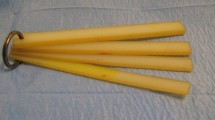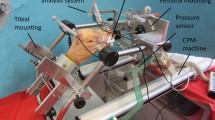Abstract
Purpose
This study’s purpose was to investigate how an ideal anatomic femoral attachment affects the dynamic length change pattern of a virtual medial patellofemoral ligament (MPFL) from an extended to a highly flexed knee position; to determine the relative length and length change pattern of a surgically reconstructed MPFL; and to correlate femoral attachment positioning, length change pattern, and relative graft length with the clinical outcome.
Methods
Twenty-four knees with isolated nonanatomic MPFL reconstruction were analysed by three-dimensional computed tomography at 0°, 30°, 60°, 90°, and 120° of knee flexion. The lengths of the MPFL graft and a virtual anatomic MPFL were measured. The pattern of length change was considered isometric if the length distance changed <5 mm through the entire dynamic range of motion.
Results
Knee flexion significantly affected the path lengths between the femoral and patellar attachments. The length of the anatomic virtual MPFL decreased significantly from 60° to 120°. Its maximal length was 56.4 ± 6.8 mm at 30°. It was isometric between 0° and 60°. The length of the nonanatomic MPFL with a satisfactory clinical result decreased during flexion from 0° to 120°. Its maximal length was 51.6 ± 4.6 mm at 0° of knee flexion. The lengths measured at 0° and 30° were isometric and statistically greater than the lengths measured at higher flexion degrees. The failed nonanatomic MPFL reconstructions were isometric throughout the dynamic range, being significantly shorter (27.1 ± 13.3 %) than anatomic ligaments.
Conclusion
The femoral attachment point significantly influences the relative length and the dynamic length change of the grafts during knee flexion–extension and graft isometry. Moreover, it influences the long-term outcome of the MPFL reconstructive surgery. A nonanatomic femoral fixation point should not be considered the cause of persistent pain and instability after MPFL reconstruction in all cases.
Level of evidence
III.








Similar content being viewed by others
Change history
02 November 2018
Unfortunately, the author missed out to indicate the affiliation which is basic requirement as a part of his thesis. The affiliation is now updated here.
02 November 2018
Unfortunately, the author missed out to indicate the affiliation which is basic requirement as a part of his thesis. The affiliation is now updated here.
References
Amis AA, Firer P, Mountney J, Senavongse W, Thomas NP (2003) Anatomy and biomechanics of the medial patellofemoral ligament. Knee 10(3):215–220
Camp CL, Krych AJ, Dahm DL, Levy BA, Stuart MJ (2010) Medial patellofemoral ligament repair for recurrent patellar dislocation. Am J Sports Med 38(11):2248–2254
Conlan T, Garth WP Jr, Lemons JE (1993) Evaluation of the medial soft-tissue restraints of the extensor mechanism of the knee. J Bone Joint Surg Am 75(5):682–693
Dejour D, Le Coultre B (2007) Osteotomies in patellofemoral instabilities. Sports Med Arthrosc 15:39–46
Desio SM, Burks RT, Bachus KN (1998) Soft tissue restraints to lateral patellar translation in the human knee. Am J Sports Med 26(1):59–65
Elias JJ, Cosgarea AJ (2006) Technical errors during medial patellofemoral ligament reconstruction could overload medial patellofemoral cartilage: a computational analysis. Am J Sports Med 34:1478–1485
Fujino K, Tajima G, Yan J, Kamei Y, Maruyama M, Takeda S, Kikuchi S, Shimamura T (2015) Morphology of the femoral insertion site of the medial patellofemoral ligament. Knee Surg Sports Traumatol Arthrosc 23(4):998–1003
Good L (1995) In vitro correlation between tension and length change in an anterior cruciate ligament substitute. Clin Biomech (Bristol, Avon) 10(4):200–207
Graf M, Diether S, Vlachopoulos L, Fucentese S, Fürnstahl P (2014) Automatic string generation for estimating in vivo length changes of the medial patellofemoral ligament during knee flexion. Med Biol Eng Comput 52(6):511–520
Hautamaa PV, Fithian DC, Kaufman KR, Daniel DM, Pohlmeyer AM (1998) Medial soft tissue restraints in lateral patellar instability and repair. Clin Orthop Relat Res 349:174–182
Higuchi T, Arai Y, Takamiya H, Miyamoto T, Tokunaga D, Kubo T (2010) An analysis of the medial patellofemoral ligament length change pattern using open-MRI. Knee Surg Sports Traumatol Arthrosc 18:1470–1475
Hirschmann MT, Mathis D, Rasch H, Amsler F, Friederich NF, Arnold MP (2013) SPECT/CT tracer uptake is influenced by tunnel orientation and position of the femoral and tibial ACL graft insertion site. Int Orthop 37(2):301–309
Hopper GP, Leach WJ, Rooney BP, Walker CR, Blyth MJ (2014) Does degree of trochlear dysplasia and position of femoral tunnel influence outcome after medial patellofemoral ligament reconstruction? Am J Sports Med 42(3):716–722
Jeong WS, Yoo YS, Kim DY, Shetty NS, Smolinski P, Logishetty K, Ranawat A (2010) An analysis of the posterior cruciate ligament isometric position using an in vivo 3-dimensional computed tomography-based knee joint model. Arthroscopy 26(10):1333–1339
Kang HJ, Wang F, Chen BC, Su YL, Zhang ZC, Yan CB (2010) Functional bundles of the medial patellofemoral ligament. Knee Surg Sports Traumatol Arthrosc 18:1511–1516
Kita K, Tanaka Y, Toritsuka Y, Amano H, Uchida R, Takao R, Horibe S (2015) Factors affecting the outcomes of double-bundle medial patellofemoral ligament reconstruction for recurrent patellar dislocations evaluated by multivariate analysis. Am J Sports Med. doi: 10.1177/0363546515606102
Matsushita T, Kuroda R, Oka S, Matsumoto T, Takayama K, Kurosaka M (2014) Clinical outcomes of medial patellofemoral ligament reconstruction in patients with an increased tibial tuberosity-trochlear groove distance. Knee Surg Sports Traumatol Arthrosc 22(10):2438–2444
Moritomo H, Noda K, Goto A, Murase T, Yoshikawa H, Sugamoto K (2009) Interosseous membrane of the forearm: length change of ligaments during forearm rotation. J Hand Surg Am 34(4):685–691
Nomura E, Inoue M, Osada N (2005) Anatomical analysis of the medial patellofemoral ligament of the knee, especially the femoral attachment. Knee Surg Sports Traumatol Arthrosc 13(7):510–515
Nishimori M, Deie M, Adachi N, Nakamae A, Ishifuro M, Ochi M (2014) Simulated anterior cruciate ligament reconstruction using preoperative three-dimensional computed tomography. Knee Surg Sports Traumatol Arthrosc 22(5):1175–1181
Oka S, Matsushita T, Kubo S, Matsumoto T, Tajimi H, Kurosaka M, Kuroda R (2014) Simulation of the optimal femoral insertion site in medial patellofemoral ligament reconstruction. Knee Surg Sports Traumatol Arthrosc. doi:10.1007/s00167-014-3192-1
Sanchis-Alfonso V (2014) Guidelines for medial patellofemoral ligament reconstruction in chronic lateral patellar instability. J Am Acad Orthop Surg 22:175–182
Sanchis-Alfonso V, Ramirez-Fuentes C, Montesinos-Berry E, Aparisi-Rodriguez F, Martí-Bonmatí L (2015) Does radiographic location ensure precise location of the femoral fixation site in medial patellofemoral ligament surgery? Knee Surg Sports Traumatol Arthrosc. doi:10.1007/s00167-015-3523-x
Schoettle PB, Schmeling A, Rosenstiel N, Weiler A (2007) Radiographic landmarks for femoral tunnel placement in medial patellofemoral ligament reconstruction. Am J Sports Med 35:801–804
Seo YJ, Song SY, Kim IS, Seo MJ, Kim YS, Yoo YS (2014) Graft tension of the posterior cruciate ligament using a finite element model. Knee Surg Sports Traumatol Arthrosc 22(9):2057–2063
Servien E, Fritsch B, Lustig S, Demey G, Debarge R, Lapra C, Neyret P (2011) In vivo positioning analysis of medial patellofemoral ligament reconstruction. Am J Sports Med 39:134–139
Smirk C, Morris H (2003) The anatomy and reconstruction of the medial patellofemoral ligament. Knee 10:221–227
Steensen RN, Dopirak RM, McDonald WG 3rd (2004) The anatomy and isometry of the medial patellofemoral ligament: implications for reconstruction. Am J Sports Med 32:1509–1513
Stephen JM, Lumpaopong P, Deehan DJ, Kader D, Amis AA (2012) The medial patellofemoral ligament: location of femoral attachment and length change patterns resulting from anatomic and nonanatomic attachments. Am J Sports Med 40(8):1871–1879
Song SY, Pang CH, Kim CH, Kim J, Choi ML, Seo YJ (2015) Length change behavior of virtual medial patellofemoral ligament fibers during in vivo knee flexion. Am J Sports Med 43(5):1165–1171
Tan J, Xu J, Xie RG, Deng AD, Tang JB (2011) In vivo length and changes of ligaments stabilizing the thumb carpometacarpal joint. J Hand Surg Am 36(3):420–427
Tateishi T, Tsuchiya M, Motosugi N, Asahina S, Ikeda H, Cho S, Muneta T (2011) Graft length change and radiographic assessment of femoral drill hole position for medial patellofemoral ligament reconstruction. Knee Surg Sports Traumatol Arthrosc 19:400–407
Thaunat M, Erasmus PJ (2007) The favourable anisometry: an original concept for medial patellofemoral ligament reconstruction. Knee 14:424–428
Victor J, Wong P, Witvrouw E, Sloten JV, Bellemans J (2009) How isometric are the medial patellofemoral, superficial medial collateral, and lateral collateral ligaments of the knee? Am J Sports Med 37:2028–2036
Wagner D, Pfalzer F, Hingelbaum S, Huth J, Mauch F, Bauer G (2013) The influence of risk factors on clinical outcomes following anatomical medial patellofemoral ligament (MPFL) reconstruction using the gracilis tendon. Knee Surg Sports Traumatol Arthrosc 21(2):318–324
Yoo YS, Chang HG, Seo YJ, Byun JC, Lee GK, Im H, Song SY (2012) Changes in the length of the medial patellofemoral ligament: an in vivo analysis using 3-Dimensional computed tomography. Am J Sports Med 40(9):2142–2148
Yoo YS, Jeong WS, Shetty NS, Ingham SJ, Smolinski P, Fu F (2010) Changes in ACL length at different knee flexion angles: an in vivo biomechanical study. Knee Surg Sports Traumatol Arthrosc 18(3):292–297
Author information
Authors and Affiliations
Corresponding author
Rights and permissions
About this article
Cite this article
Sanchis-Alfonso, V., Ramirez-Fuentes, C., Montesinos-Berry, E. et al. Femoral insertion site of the graft used to replace the medial patellofemoral ligament influences the ligament dynamic changes during knee flexion and the clinical outcome. Knee Surg Sports Traumatol Arthrosc 25, 2433–2441 (2017). https://doi.org/10.1007/s00167-015-3905-0
Received:
Accepted:
Published:
Issue Date:
DOI: https://doi.org/10.1007/s00167-015-3905-0




